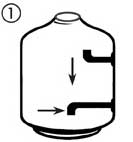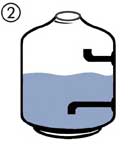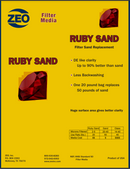Description
Ruby Sand Filter Sand Replacement
Nominal filtration: 3-5 microns
Ruby Sand, porous ceramic, is a sand replacement that has been used by the water filtration industry for many years. The primary reason for Ruby Sand’s rapid acceptance by the filtration industry is improved clarity (3 to 5 microns) of Ruby Sand versus sand (20 to 40 microns).
Crystal Clear Water
One 20 lb. bag of Ruby Sand is equal to one 50 lb. Bag of Silica Sand (when Replacing Sand with Ruby Sand go bag for bag not by weight.)
Improved Clarity
- DE Like Clarity–Up to 90% Better than Sand
- Huge Surface Area Traps More Dirt
- Saves Water–Fewer Backwashes
Ion Exchange
- Purifies Water
- Traps Ammonia, Chloramines and Heavy Metals
Proven
- Residential and Commercial Uses
Long Lasting
- Lasts as Long or Longer than
Sand or Glass
Installation
Following these simple installation steps will lead to years of crystal clear water.
Easy Steps:
- Remove sand and make needed repairs.
- For each 20 pound bag of Ruby Sand, dissolve 3 tablespoons of Cal-Hypo (68% min) or Di-Chlor in about one quart of water.
- Add to filter.
- Fill filter halfway with water.
- Pour the Ruby Sand into the filter.
- Let soak for 20 minutes.
- Backwash until clear water comes from the filter.
Ruby Sand contains a small percentage of tan dust due to its production process, so following these installation instructions is extremely important.
Nearly all of the Ruby Sand tech service calls are due to faulty installation. Faulty installation—dust in the pool—is fixable
In Step One, ZEO recommends that the chlorine or sanitizer, phosphate remover, and algaecide levels be adjusted to the high end of their normal range. Ruby Sand is compatible with all pool chemicals like sanitizers, phosphate removers, enzymes, and algaecides. In addition, Ruby Sand is compatible with all out board sanitizer generators like chlorine, ozone and ultraviolet. The natural Ruby Sand color does not wash off and dye the pool water.
Water Saving Tip
Pool or spa water can be saved by pre-rinsing Ruby Sand in a bucket to remove most of the tan dust. Pour the Ruby Sand in a bucket and rinse with a garden hose until most of the dust is removed. Then, follow normal installation instructions to make sure all of the remaining dust is removed. This tip is especially useful for small volume pools with small filters and spas with large filters
Step 1

- Determine the amount of media required for your sand filter based on the Ruby Sand replacement ratio.
- Adjust sanitizer, phosphate remover, and algaecide to the high end of the normal range.
- With the filter electricity off, empty filter and make any needed repairs.
- For each 20 pound bag of Ruby Sand, dissolve 3 tablespoons of Cal-Hypo (68% min) or Di-Chlor in about one quart of water.
- Add to filter.
Step 2

- Fill filter half-way with water.
Step 3

- Slowly pour Ruby Sand into filter allowing all media granules to be thoroughly wetted.
- Make sure no media enters lateral piping assembly.
- Let soak for 20 minutes.
Step 4

- Close filter and backwash until backwash water is clear.
- Allow Ruby Sand to settle for 5 minutes.
- Backwash for an additional minute.
- Rinse for 30 seconds.
- Turn filter to Filter Mode.
Ruby Sand Comparison
Ruby Sand’s high surface area and low bulk density porous ceramic structure results from the flash removal of water in the aluminosilicate structure. The 1,200° plus manufacturing process rapidly vaporizes the water in the aluminosilicate mineral and leaves behind a rough porous ceramic type structure.
Here is how Ruby Sand compares to other filer media used in sand filters:
ZEO Ruby Sand Natural Zeolite Filter Media
|
|||
SURFACE AREA |
|||
| Ruby Sand | |||
| ZeoSand | |||
| Other Zeolite | |||
| Glass | |||
| Sand | < 0.1 | ||
| POUNDS/CUBIC FOOT | POUNDS/BAG | ||
| Ruby Sand | |||
| ZeoSand | |||
| Other Zeolite | |||
| Glass | |||
| Sand | 50 | ||
| AMMONIA HOLDING | |||
| Ruby Sand | |||
| ZeoSand | |||
| Other Zeolite | |||
| Glass | |||
| Sand | |||
Use Rate
Ruby Sand Porous Ceramic Filter Media
The most important step in using Ruby Sand is to follow the installation instructions.
20 pounds of Ruby Sand replaces 50 pounds of sand or 40 pounds of glass.
|
||
| 17 | ||
| 1,000 | 400 | |
|
© ZEO, Inc. Ruby Sand Natural Zeolite Filter Media
|
||
|
|||
(Lbs./cu. Ft.) |
|||
Ruby Sand |
40 |
||
Sand |
100 |
||
Glass |
80 |
||
|
© ZEO, Inc. Ruby Sand Natural Zeolite Filter Media
|
|||
Many larger filters have filter media recommendations with and without pea gravel. Ruby Sand can be successfully used with and without pea gravel. Follow the filter manufacture’s instructions. The consensus of our customers favors the use of pea gravel that serves to protect the laterals and to disperse the water flow.
1. Product identifier
Other product identifiers: Montmorillonite, calcined
CAS Number: 70892-59-0
Recommended use and restriction on use
Recommended use: Sand replacement filter media for water.
Restrictions on use: No relevant information available.
Details of the supplier of the Safety Data Sheet
Manufacturer/Supplier:
ZEO, Inc.
2104 Augusta Street
McKinney, TX 75070
Phone: +1-972-542-0053
Fax: +1-972-542-0211
Emergency telephone number: +1-972-542-0053
2. Hazard Identification
The substance is not classified as hazardous according to the Globally Harmonized System (GHS).
Label elements
GHS label elements: Not regulated.
Hazard pictograms: Not regulated.
Signal word: Not regulated.
Hazard statements: Not regulated.
Precautionary statements: Not regulated.
Other hazards: There are no other hazards not otherwise classified that have been identified.
3. Composition, Information or Ingredients
Chemical characterization: Substances
CAS No. Description
70892-59-0 Montmorillonite, calcined
Components:
14808-60-7 Quartz (SiO2) Carc. 1A, H350; STOT RE 1, H372 3-5%
Additional Information:
Non-classification as a carcinogen is based on non-inhalable form of product. IARC listings for quartz note that the substance must be respirable.
For the listed ingredient(s), the identity and/or exact percentage(s) are being withheld as a trade secret.
For the wording of the listed Hazard Statements refer to section 16.
4. First Aid Measures
After inhalation:
Unlikely route of exposure.
Respiration of particulates is unlikely during normal usage.
Supply fresh air; consult doctor in case of complaints.
After skin contact:
Brush off loose particles from skin.
Immediately wash with water and soap and rinse thoroughly.
If skin irritation continues, consult a doctor.
After eye contact:
Remove contact lenses if worn.
Rinse opened eye at least 15 minutes under running water.
Seek medical treatment in case of complaints.
After swallowing: Do not induce vomiting; immediately call for medical help.
Most important symptoms and effects, both acute and delayed: No relevant information available.
Indication of any immediate medical attention and special treatment needed:
If medical advice is needed, have product container or label at hand.
5. Fire-Fighting Measure
Suitable extinguishing agents:
The product is not flammable.
Use fire fighting measures that suit the environment.
For safety reasons unsuitable extinguishing agents: None.
Special hazards arising from the substance or mixture No relevant information available.
Advice for firefighters
Protective equipment:
Wear self-contained respiratory protective device.
Wear fully protective suit.
6. Accidental Release Measures
Ensure adequate ventilation.
Avoid formation of dust.
Do not breathe dust.
If airborne dust and/or fume is present, use adequate engineering controls and, if needed, personal
protection to prevent overexposure. Refer to recommendations in Section 8.
Environmental precautions: Not considered hazardous.
· Methods and material for containment and cleaning up:
Treat discarded material as a respiratory hazard.
Vacuum or sweep and collect in a suitable container. For a large spill, collect uncontaminated product for
possible re-use. Avoid creating dusty conditions.
7. Handling and Storage
Precautions for safe handling:
Ensure good ventilation/exhaustion at the workplace.
Use personal protective equipment as required.
Take off contaminated clothing and wash it before reuse.
Wash hands before breaks and at the end of work.
Conditions for safe storage, including any incompatibilities
Storage
Requirements to be met by storerooms and receptacles:
Storage area should be dry and well-ventilated.
Information about storage in one common storage facility: Store away from foodstuffs.
Specific end use(s): No relevant information available.
8. Exposure Controls and Personal Protection
Control parameters
Components with limit values that require monitoring at the workplace:
14808-60-7 Quartz (SiO2)
PEL (USA) see Quartz listing
REL (USA) Long-term value: 0.05* mg/m³
*respirable dust; See Pocket Guide App. A
TLV (USA) Long-term value: 0.025* mg/m³
*as respirable fraction
EL (Canada) Long-term value: 0.025 mg/m³
ACGIH A2; IARC 1
EV (Canada) Long-term value: 0.10* mg/m³
*respirable fraction
LMPE (Mexico) Long-term value: 0.025* mg/m³
A2, *fracción respirable
Exposure controls
Engineering measures
Use general dilution ventilation and/or local exhaust ventilation to maintain exposures below occupational
exposure limits.
Personal protective equipment:
General protective and hygienic measures:
The usual precautionary measures for handling chemicals should be followed.
9. Physical and Chemical Properties
Appearance:
Form: Granulate
Color: Light brown
Odor: Negligible
Odor threshold: Not determined.
pH-value: Not applicable.
Melting point/Melting range: Not determined.
Boiling point/Boiling range: Not determined.
Flash point: Not applicable.
Flammability (solid, gaseous): Not determined.
Auto-ignition temperature: Not determined.
Decomposition temperature: Not determined.
Danger of explosion: Product does not present an explosion hazard.
Explosion limits
Lower: Not determined.
Upper: Not determined.
Oxidizing properties: Non-oxidizing.
Vapor pressure: Not determined.
Density at 20 °C (68 °F): 1.5 g/cm³ (12.518 lbs/gal)
Relative density: Not determined.
Payment & Security
Your payment information is processed securely. We do not store credit card details nor have access to your credit card information.















